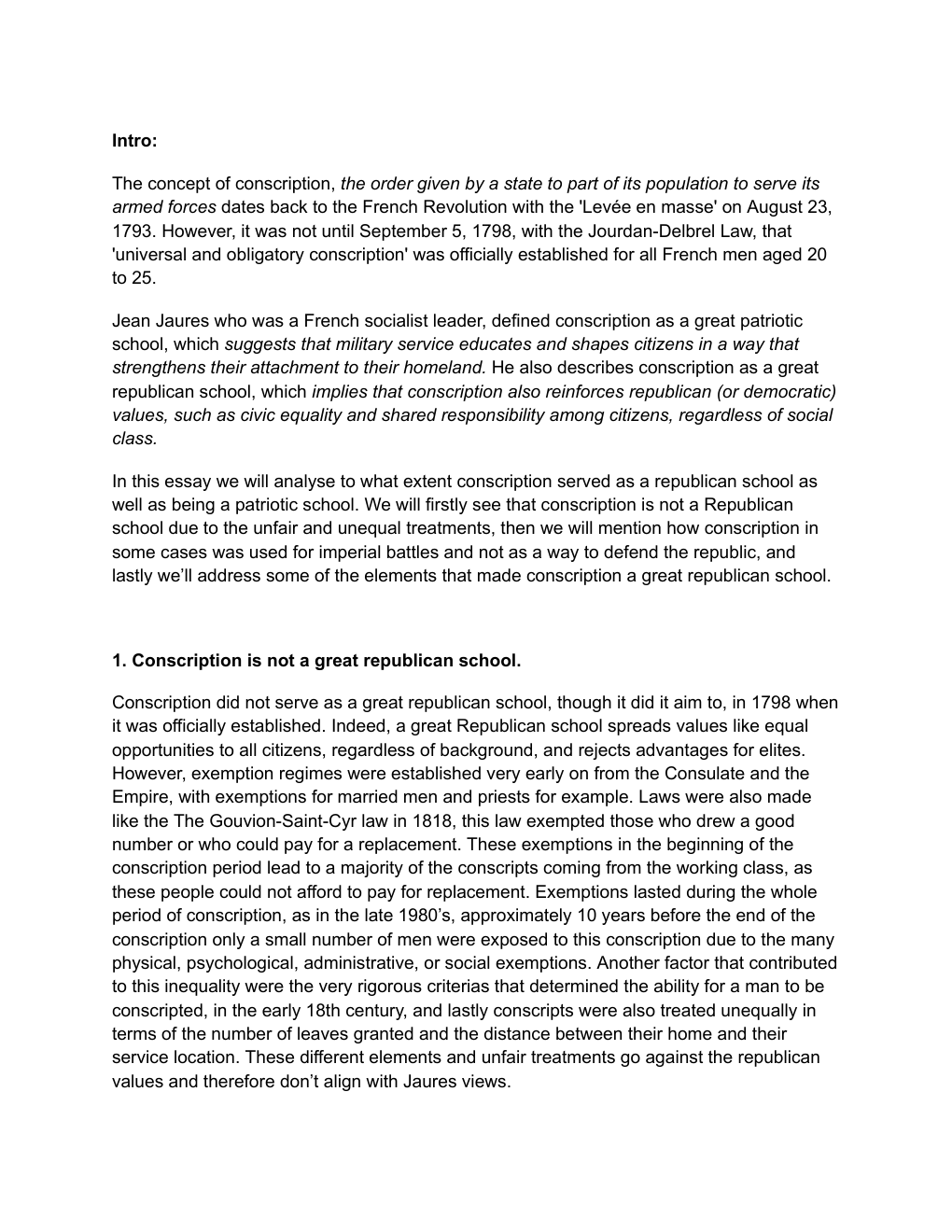Essai/composition sur la Conscription en France en anglais
Publié le 15/05/2025
Extrait du document
«
Intro:
The concept of conscription, the order given by a state to part of its population to serve its
armed forces dates back to the French Revolution with the 'Levée en masse' on August 23,
1793.
However, it was not until September 5, 1798, with the Jourdan-Delbrel Law, that
'universal and obligatory conscription' was officially established for all French men aged 20
to 25.
Jean Jaures who was a French socialist leader, defined conscription as a great patriotic
school, which suggests that military service educates and shapes citizens in a way that
strengthens their attachment to their homeland.
He also describes conscription as a great
republican school, which implies that conscription also reinforces republican (or democratic)
values, such as civic equality and shared responsibility among citizens, regardless of social
class.
In this essay we will analyse to what extent conscription served as a republican school as
well as being a patriotic school.
We will firstly see that conscription is not a Republican
school due to the unfair and unequal treatments, then we will mention how conscription in
some cases was used for imperial battles and not as a way to defend the republic, and
lastly we’ll address some of the elements that made conscription a great republican school.
1.
Conscription is not a great republican school.
Conscription did not serve as a great republican school, though it did it aim to, in 1798 when
it was officially established.
Indeed, a great Republican school spreads values like equal
opportunities to all citizens, regardless of background, and rejects advantages for elites.
However, exemption regimes were established very early on from the Consulate and the
Empire, with exemptions for married men and priests for example.
Laws were also made
like the The Gouvion-Saint-Cyr law in 1818, this law exempted those who drew a good
number or who could pay for a replacement.
These exemptions in the beginning of the
conscription period lead to a majority of the conscripts coming from the working class, as
these people could not afford to pay for replacement.
Exemptions lasted during the whole
period of conscription, as in the late 1980’s, approximately 10 years before the end of the
conscription only a small number of men were exposed to this conscription due to the many
physical, psychological, administrative, or social exemptions.
Another factor that contributed
to this inequality were the very rigorous criterias that determined the ability for a man to be
conscripted, in the....
»
↓↓↓ APERÇU DU DOCUMENT ↓↓↓
Liens utiles
- DUPERRE, Victor Guy, baron (1775-1846)Amiral, il se distingue dans la lutte avec les navires anglais et est fait baron d'Empire, puis pair de France par Charles X et nommé amiral par Louis-Philippe.
- MONTCALM DE SAINT-VERAN, Louis Joseph, marquis de (1712-1759)Général français, il prend la tête des troupes conquérantes du Nouvelle-France au Canada en 1756 et enlève quelques places fortes aux Anglais avant de périr au combat en défendant Québec.
- BRIENNE, Raoul de (mort en 1350)Connétable de France fait prisonnier en 1346 par les Anglais, il est libéré sur rançon en 1350.
- ARTHUR III (1393-1458)Comte de Richemont, connétable de France, duc de Bretagne de 1457 à 1458, il est l'un des meilleurs généraux de Charles VII et combat les Anglais.
- FRANÇOIS II de BRETAGNE (1435-1488)Après le mariage du Téméraire avec Marguerite d'York, Bretons, Anglais, Bourguignons se montrent prêts à frapper un grand coup contre la France.

































